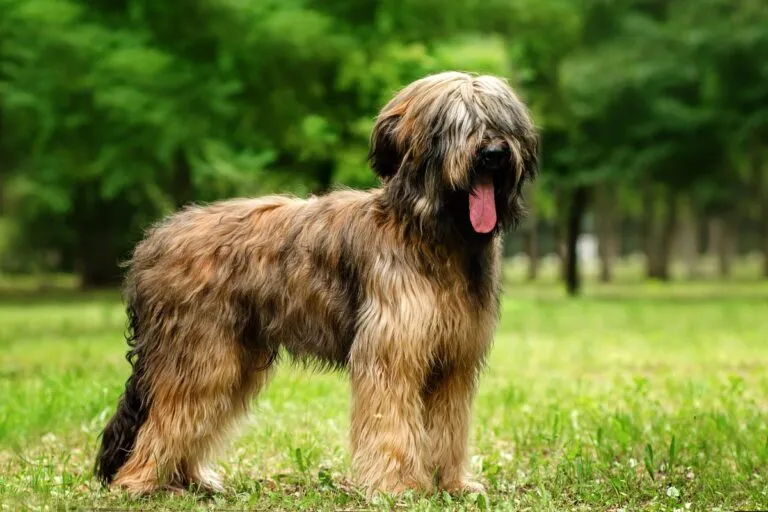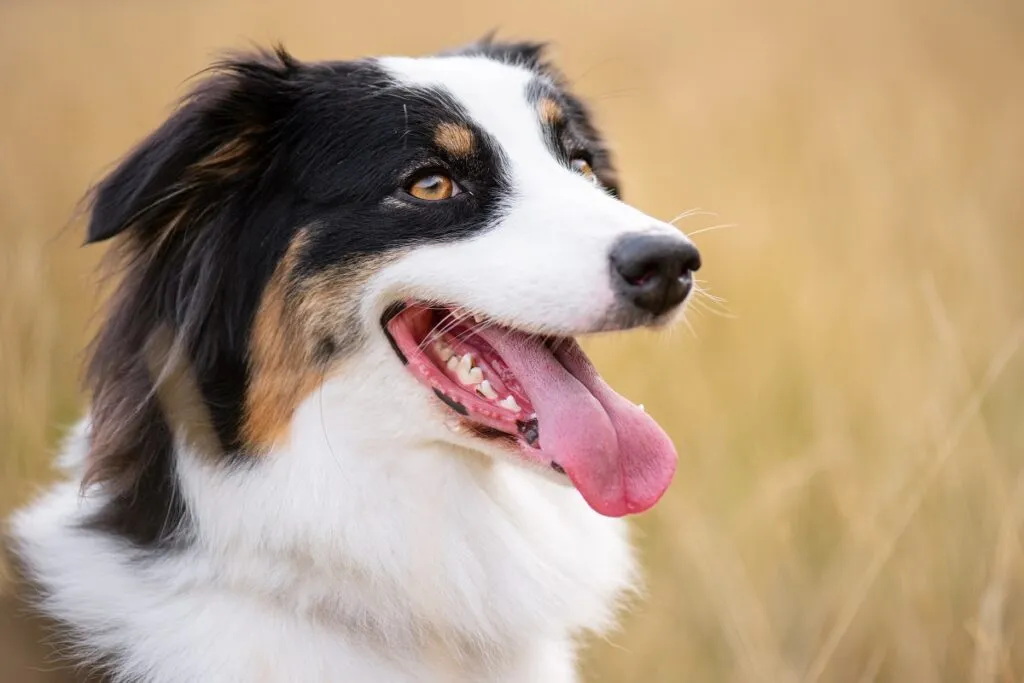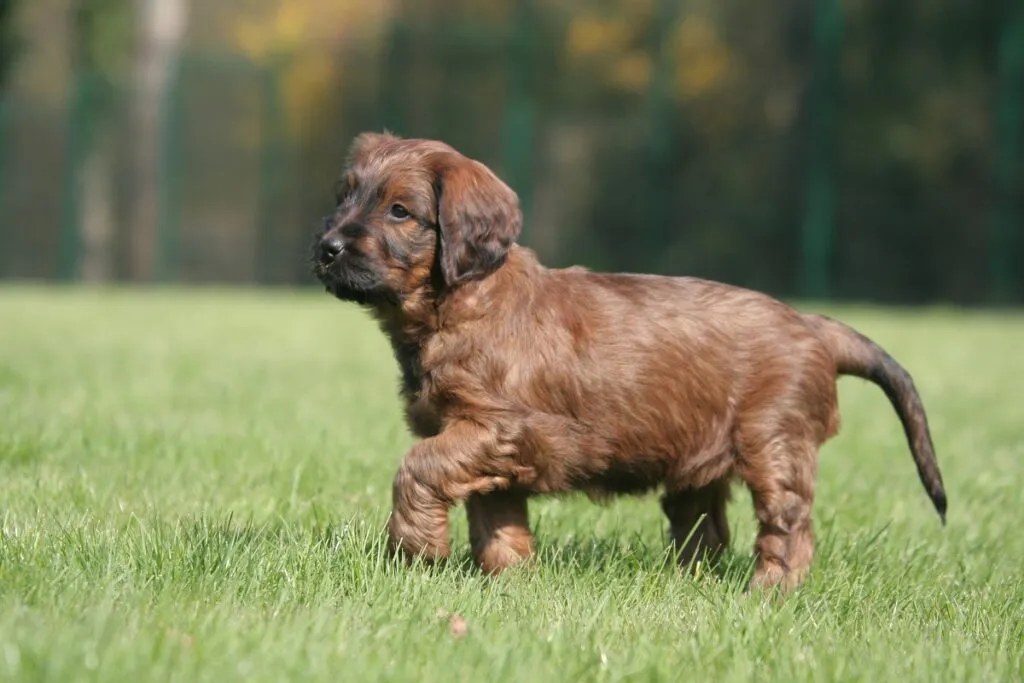Medium Size Poodle
The Wäller is a young German herding dog breed from the Westerwald region. As the breed is not yet recognised by the FCI, the 1st Wäller Club of Germany oversees the unconventional breeding. Discover more about these loveable four-legged friends with their shaggy fur here.

© Kate / stock.adobe.com
The Wäller is a crossbreed of the Briard and the Australian Shepherd.
The Wäller originated in the Westerwald area of Germany. The name derives from a nickname for the human inhabitants of this area, who are also called Wällers.
The breed has not been around for long: Breeding began in 1994 with the aim of creating an agile, healthy family dog with a good disposition to be a companion dog. Breeders mainly used the Briard and Australian Shepherd as foundation breeds.
In many dog breeds, breeding standards emphasise a certain appearance deemed typical of the breed. Not so with the Wäller: what the dogs look like is not crucial.
Instead, robust health and desirable character traits are the priorities. The breeders meticulously ensure no inbreeding occurs, aiming instead to establish a large, healthy gene pool.
They regularly introduce the Briard and Australian Shepherd foundation breeds into the mix. In this way, as many different animals as possible are available for breeding, reducing breed-related illnesses.
Good to Know: Continuously mating closely related dogs is known as inbreeding. It can lead to health issues, life weakness, or even aggression within the breed. This is consciously avoided with the Wäller.
Its large gene pool makes the Wäller a vital and robust dog, less prone to illnesses. They are well-adapted to environmental influences and resilient in the face of stressful situations.
This is reflected in their long lifespan: a Wäller typically lives to be about 12 years old, though there are cases of them reaching 16 years. As with all dogs, behavioural changes should be taken seriously. If your dog is limping or behaving unusually, please take it to the vet immediately.
Through crossbreeding with the Australian Shepherd, the Wäller has inherited some of its weaknesses. For example, some representatives of the breed can have the MDR1 genetic defect, making the dogs hypersensitive to certain drugs. Moreover, Wällers are said to have an increased tendency towards [cataracts in the eye (Grey Star)] – another legacy from the Australian Shepherd.
 © DenisNata / stock.adobe.com
© DenisNata / stock.adobe.com
What exactly does a Wäller look like? There’s no one-size-fits-all answer. The Wäller’s appearance varies widely because the focus in breeding was on character and health, not looks.
As a result, a breed with many different variations emerges. Sometimes, you may need a second glance to identify a Wäller.
The following features characterise the Wäller:
The goal for the Wäller is to be a medium-sized, elegant dog. The aim is not to produce especially athletic dogs with strong muscles but to achieve a balanced, slender appearance.
However, this does not mean the Wäller lacks athleticism. Its dynamic structure is simply concealed by the often dense fur, creating the impression of a cuddly, comfort-loving dog. But this impression fades once you see these dogs in action: with the Australian Shepherd in their lineage, Wällers are animated and evenly balanced dogs that excel in everyday activities.
The Wäller is a playful and friendly dog. It loves accompanying its humans everywhere, catering to its eager enthusiasm for movement.
The will-to-please is strong—meaning the dog is willing to respond to its human’s wishes and needs. It aims to please its owner and is motivated by praise.
Since it is easy to motivate and excite, it thrives on a variety of tasks. Intelligence games combined with learning tricks are particularly satisfying for these enduring, people-oriented family dogs.
The Wäller has a very patient and forgiving nature, so it has no trouble with children. After a short adjustment period, it accepts kids and is excited to spend time with them. After all, something is always happening around them – and that’s what the inquisitive Wäller loves. If things don’t go as planned, it hardly bothers the breed: they are adaptable and continually amused by the unpredictability of children.
If you don’t have much experience with dogs, the Wäller provides an uncomplicated start. It is easy to train and is not rebellious. However, even the Wäller needs consistent training from puppyhood. You must actively educate and acquaint the dog with danger, other animals, and children.
Remember: A family dog is not born but is created through loving guidance and attention.
Since the Wäller is a very friendly dog with a love for exercise, it is excellent for active families with a diverse range of leisure activities.
You can confidently take the Wäller with you on a mountain tour at the weekend, on your morning jog, or when cycling to the lake. In everyday life, one or two long walks a day should suffice to tire out the furry bundle.
Of course, after an active day, it also enjoys cuddling and provides its family with unobtrusive company. Purely indoor or household living, however, is not recommended for these active bundles of energy.
Wällers need plenty of exercise and enjoy play. Why not combine the two? Agility, Mantrailing, or Flyball are perfect activities for these exercise enthusiasts.
Their high intellect allows them to quickly adapt to new circumstances and swiftly respond to situational demands. The thrill of novelty consistently motivates these dogs to perform their best. Ensure you keep bringing in new toys for the Wäller to engage with, or try out a new dog sport with them. Plenty of daytime activities keep the four-legged friend in shape, ensuring calm evenings and nights.
The Wäller is quite straightforward when it comes to food. You should always look for good quality in choosing the right food to ensure the animal enjoys a long and trouble-free dog’s life.
You can recognise this by the few additives and high-quality ingredients with a clear origin. Examine the ingredients list carefully: Is meat the main component?
The following feeding guidelines apply to the Wäller and almost every other dog breed:
For the Wäller too, Barfing is an excellent nutrition method. This feeding approach involves supplying the dog with raw meat, bones, vegetables, or grain.
The fresh meals contain many good substances and are highly digestible. Barfing has many benefits: it strengthens muscles and dental care, prevents bad breath, and minimises allergies. Sure: preparing fresh portions for one or more dogs takes time. But it is time well spent. Moreover, Barfing generally does not cost more than high-quality organic dog food.
 © Cani / stock.adobe.com
© Cani / stock.adobe.com
With a Wäller, you have chosen a rather long-haired dog. As long as you don’t shave it, it requires extensive coat care at least once a week.
For specimens with longer, wavy fur, this can take up to an hour. Especially after extensive walks or in poor weather, the dogs bring in quite a lot of dirt.
With a towel, suitable brushes, and grooming products, however, you can quickly remedy the situation.
Have you fallen for the Wäller and want to adopt one? Then budget for 1,300 to 1,500 euros. The Wäller is a rather rare breed and hard to come by outside of Germany.
If interested, approach the 1st Wäller Club of Germany directly. They are the contact point for the breed in German-speaking countries and can advise you on acquisition and care. The non-profit association also connects you with reputable breeders.
The Wäller is a well-balanced and fearless family and leisure-time dog with few weaknesses. Its breeding, which focuses on healthy and sound animals, results in a wide variety of forms.
This means there’s a suitable dog for everyone, whether you’re looking for long-haired to almost short-haired, or smooth to shaggy.
If you get a Wäller, be aware of its active nature and high intelligence. Bring along enough time that you can dedicate to caring for the animal and providing mental stimulation.
The breed is the ideal partner for people and families who love to be outdoors and are looking for a cheerful and grateful companion.
| Specialties: | A stable, active herding dog with variable looks resulting from a German breeding programme focused on health and character. |
| Character: | cheerful, controllable, eager |
| Withers Height: | Male: 55 – 65 cm Female: 50 – 60 cm |
| Weight: | Male: 27 – 30 kg Female: 26 – 29 kg |
| Coat: | medium or long/all colours/smooth, wavy or shaggy |
| Coat Care: | demanding, weekly brushing needed |
| Exercise: | substantial, at least 2 hours a day |
| Beginner-Friendly: | yes |
| Barking: | average |
| Lifespan: | 12 years |
| Typical Illnesses: | Grey Star, MDR1 defect |
| Price: | 1,300 – 1,500 € |
| FCI Group: | not recognised |
| Origin: | Germany |
Here are some purchase proposals curated by the zooplus editorial team
The products featured have been carefully selected by our editorial staff and are available at the zooplus online pet shop. The selection does not constitute advertising for the mentioned brands.
Fans of the Bearded Collie agree that those who aren't familiar with this dog breed simply have to get acquainted with it. And those who have experienced how a Bearded Collie bolts across meadows with its flowing fur, how it rolls around full of energy and joy and how it attentively and observantly takes into account its owners wishes become simply addicted to this original dog breed and its unique charm.
The Goldendoodle isn't a breed, but a pairing between Golden Retrievers and Medium or Standard Poodles. Marketed as a low-maintenance dog for allergy sufferers, this hybrid is enjoying increasing popularity amongst dog lovers, similar to the Labradoodle.